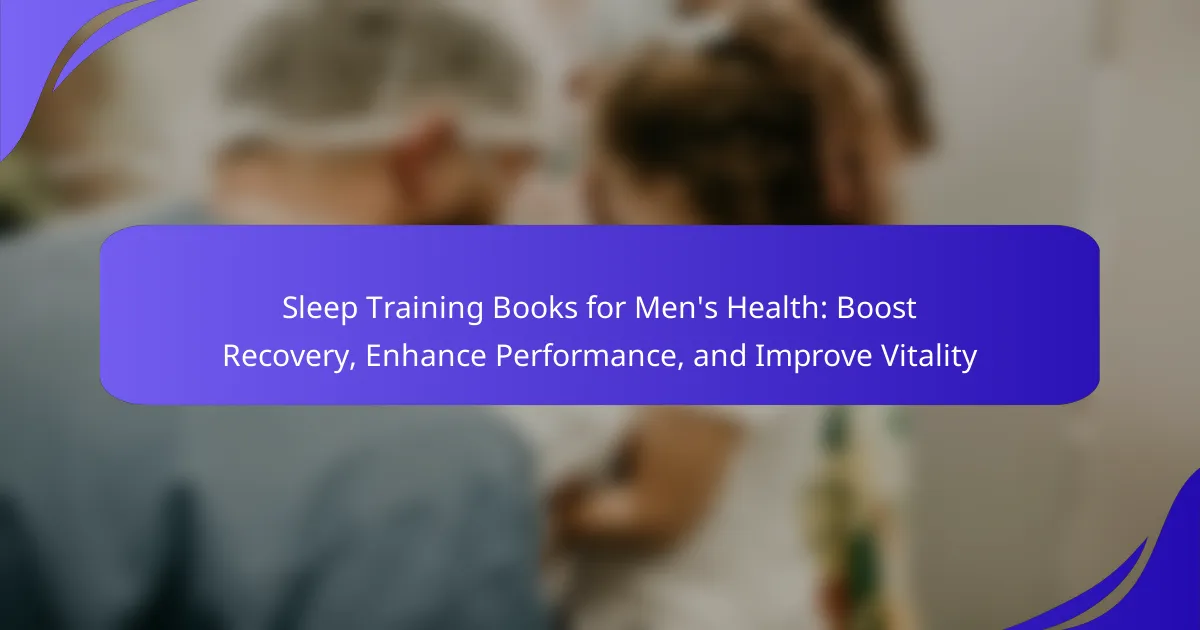Achieving peak performance in men’s fitness requires understanding the importance of strength gains, optimal recovery, and setting high expectations. This article explores structured training regimens, the role of nutrition in muscle repair, and effective recovery strategies. It emphasizes progressive overload techniques, personalized hydration protocols, and the significance of tracking performance metrics. By focusing on these elements, men can enhance their fitness journey and achieve realistic goals.

What are the key components of peak performance in men’s fitness?
Achieving peak performance in men’s fitness involves strength gains, optimal recovery, and high expectations. Key components include structured training regimens, proper nutrition, and adequate rest.
Strength gains are driven by progressive overload, where increasing resistance leads to muscle adaptation. Nutrition plays a critical role, emphasizing protein intake for muscle repair and growth. Recovery, often overlooked, is essential; it includes sleep quality and active recovery strategies to prevent overtraining.
Incorporating these elements creates a holistic approach to fitness, enhancing overall performance and well-being. Regular assessments and adjustments ensure alignment with fitness goals, fostering continuous improvement.
How does nutrition influence peak performance?
Nutrition significantly influences peak performance by providing essential nutrients that enhance strength gains and optimize recovery. Consuming a balanced diet rich in proteins, carbohydrates, and healthy fats supports muscle repair and energy levels. For example, adequate protein intake promotes muscle synthesis, while carbohydrates replenish glycogen stores, crucial for sustained energy during workouts. Hydration also plays a vital role, as even mild dehydration can impair physical performance. Prioritizing nutrient timing, such as consuming protein and carbohydrates post-exercise, can further enhance recovery and performance outcomes.
What are the essential macronutrients for strength gains?
Protein, carbohydrates, and fats are essential macronutrients for strength gains. Protein supports muscle repair and growth, with a recommended intake of 1.6 to 2.2 grams per kilogram of body weight. Carbohydrates provide energy for high-intensity workouts, ideally comprising 45-65% of total daily calories. Healthy fats, making up 20-35% of daily intake, aid hormone production and nutrient absorption. Balancing these macronutrients optimizes performance and recovery in men’s fitness.
Which micronutrients support optimal recovery?
Micronutrients such as magnesium, zinc, vitamin D, and vitamin C significantly support optimal recovery. Magnesium aids muscle relaxation and reduces cramps, while zinc contributes to immune function and protein synthesis. Vitamin D enhances muscle function and recovery, and vitamin C supports collagen synthesis and reduces inflammation. Incorporating these micronutrients into your diet can enhance recovery and overall performance.
What role does hydration play in physical performance?
Hydration significantly enhances physical performance by maintaining optimal muscle function and energy levels. Adequate fluid intake prevents dehydration, which can lead to fatigue and decreased strength. Studies show that even a 2% loss in body weight due to dehydration can impair performance, reducing endurance and increasing perceived effort. Therefore, ensuring proper hydration before, during, and after exercise is crucial for achieving peak performance and optimal recovery in men’s fitness.
How can mental conditioning enhance physical capabilities?
Mental conditioning significantly enhances physical capabilities by improving focus, resilience, and motivation. It fosters a mindset that embraces challenges, leading to peak performance in training and competition. Research shows that athletes who engage in mental conditioning techniques experience greater strength gains and faster recovery times. For example, visualization and positive self-talk can help manage stress and anxiety, allowing for optimal performance under pressure. This unique attribute of mental conditioning not only benefits physical outcomes but also supports long-term fitness goals.

What unique strategies can boost strength gains?
To boost strength gains, implement progressive overload, prioritize compound exercises, and ensure adequate recovery. These strategies enhance muscle adaptation and performance.
Progressive overload involves gradually increasing weights or resistance to challenge muscles. Compound exercises like squats and deadlifts maximize muscle engagement. Recovery, including sleep and nutrition, is essential for muscle repair and growth.
Incorporating these unique strategies can lead to significant strength improvements in men’s fitness.
Which training methods are most effective for increasing strength?
High-intensity training methods are most effective for increasing strength. These methods include progressive overload, compound movements, and high-volume training.
Progressive overload involves gradually increasing weights or resistance to stimulate muscle growth. Compound movements, such as squats and deadlifts, engage multiple muscle groups, maximizing strength gains. High-volume training, characterized by numerous sets and reps, enhances muscle endurance and hypertrophy.
Research indicates that combining these methods leads to optimal strength improvements. A study found that individuals using progressive overload achieved 20% greater strength gains compared to those who did not. Therefore, implementing these training strategies is crucial for peak performance in men’s fitness.
What is the impact of resistance training on muscle growth?
Resistance training significantly enhances muscle growth by promoting hypertrophy, which is the increase in muscle fiber size. This occurs through mechanical tension, muscle damage, and metabolic stress, leading to adaptations that improve strength and endurance. Studies show that progressive overload, where resistance is gradually increased, is crucial for maximizing these effects. Additionally, resistance training stimulates anabolic hormones like testosterone and growth hormone, further supporting muscle development. For optimal results, combining resistance training with adequate nutrition and recovery strategies is essential.
How does progressive overload contribute to strength development?
Progressive overload is essential for strength development as it systematically increases resistance, enhancing muscle adaptation. This method ensures continuous improvement by challenging the muscles beyond their current capacity, leading to increased strength gains over time. Consistent application can result in significant performance enhancements, optimizing recovery and overall fitness levels.
What unique supplements can aid in strength gains?
Creatine, beta-alanine, and branched-chain amino acids (BCAAs) are unique supplements that can significantly aid in strength gains. Creatine enhances ATP production, improving high-intensity performance. Beta-alanine buffers acid in muscles, delaying fatigue. BCAAs support muscle recovery and reduce soreness post-exercise. These supplements contribute to optimal recovery and peak performance in men’s fitness.
Which pre-workout supplements are popular among athletes?
Popular pre-workout supplements among athletes include creatine, beta-alanine, and caffeine. These enhance energy, endurance, and strength. Creatine increases ATP production, supporting high-intensity workouts. Beta-alanine helps buffer acid buildup, delaying fatigue. Caffeine boosts focus and energy levels, improving performance. Each supplement has unique benefits tailored to specific training goals.
What are the benefits of creatine for men’s fitness?
Creatine enhances men’s fitness by boosting strength, increasing muscle mass, and improving recovery times. It allows for more intense workouts and quicker replenishment of energy stores. As a result, men experience significant performance gains during high-intensity training. Studies show that creatine supplementation can lead to a 5-15% increase in strength and power output. Additionally, it may support cognitive function during physical exertion, making it a unique asset in fitness regimens.

What are the rare attributes of optimal recovery techniques?
Optimal recovery techniques for men’s fitness include unique attributes such as personalized sleep optimization, advanced hydration protocols, and targeted nutrient timing. These elements significantly enhance recovery beyond standard practices. Personalized sleep optimization focuses on individual circadian rhythms, improving rest quality. Advanced hydration protocols incorporate electrolyte balance tailored to specific workouts, promoting faster recovery. Targeted nutrient timing emphasizes immediate post-workout intake of protein and carbohydrates, maximizing muscle repair and growth.
How does sleep quality influence recovery?
Sleep quality significantly enhances recovery in men’s fitness by improving muscle repair, reducing fatigue, and optimizing hormonal balance. Quality sleep supports the body’s natural recovery processes, allowing for better strength gains and performance. Studies indicate that inadequate sleep can hinder recovery, leading to decreased athletic performance and increased injury risk. Prioritizing sleep can result in improved endurance, strength, and overall fitness outcomes.
What are the benefits of active recovery?
Active recovery enhances performance, reduces muscle soreness, and promotes faster recovery. Engaging in low-intensity activities, such as walking or cycling, improves blood flow and aids nutrient delivery to muscles. This process can lead to better strength gains and overall fitness. Studies show that active recovery can decrease lactic acid buildup, which contributes to muscle fatigue. As a result, incorporating active recovery into a fitness regimen can significantly optimize recovery and performance outcomes.
Which activities promote better recovery post-workout?
Active recovery, stretching, hydration, and nutrition significantly enhance post-workout recovery. Engaging in low-intensity activities like walking or cycling promotes blood flow, reducing muscle soreness. Incorporating static stretching improves flexibility and aids in muscle repair. Staying hydrated replenishes fluids lost during exercise, while consuming protein-rich foods supports muscle recovery.
What innovative recovery technologies are available?
Innovative recovery technologies include cryotherapy, infrared therapy, electrical stimulation, and pneumatic compression. These methods enhance muscle recovery, reduce inflammation, and improve overall performance. For example, cryotherapy can decrease muscle soreness by lowering tissue temperature, while pneumatic compression promotes blood flow and lymphatic drainage. Each technology offers unique benefits tailored to individual recovery needs.

How can men set realistic fitness expectations?
Men can set realistic fitness expectations by understanding their individual goals, current fitness levels, and the time required for progress. Establishing specific, measurable, achievable, relevant, and time-bound (SMART) goals helps maintain motivation.
For example, aiming for a 5% increase in strength over three months is more realistic than expecting peak performance immediately. Recognizing the importance of recovery is crucial; adequate rest between workouts enhances strength gains and prevents injury.
Additionally, tracking progress through metrics such as body composition and endurance can provide tangible evidence of improvements. This approach fosters a healthier mindset towards fitness, focusing on gradual growth rather than unrealistic benchmarks.
What factors influence individual performance levels?
High expectations significantly influence individual performance levels by enhancing motivation and focus. Factors such as goal setting, mental resilience, and support systems play crucial roles. Research indicates that individuals with clear, challenging goals exhibit greater strength gains and improved recovery rates. Additionally, a positive mindset can lead to better adherence to fitness regimens, ultimately resulting in peak performance.
How to track progress effectively?
To track progress effectively, establish clear metrics and regularly assess performance. Focus on strength gains, recovery times, and workout consistency. Utilize tools like fitness apps or journals to log workouts and monitor improvements. Regular evaluations help identify areas for adjustment and ensure alignment with high expectations in men’s fitness.

What are the best practices for achieving peak performance?
To achieve peak performance, focus on setting clear goals, maintaining a balanced diet, and prioritizing recovery. High expectations in men’s fitness require consistent strength training, proper nutrition, and adequate rest. Implementing progressive overload techniques enhances strength gains, while hydration and sleep optimize recovery. Tracking performance metrics can provide insights into progress and areas for improvement.
What common mistakes should be avoided in men’s fitness?
To achieve peak performance in men’s fitness, avoid setting unrealistic expectations. Common mistakes include neglecting proper recovery, overtraining, and disregarding nutrition. These errors can hinder strength gains and overall progress. Focus on gradual improvements, balanced training, and adequate rest to optimize results.
How to optimise training routines for maximum results?
To optimize training routines for maximum results, focus on structured goals, varied intensity, and adequate recovery. Establish specific performance targets to guide your workouts. Incorporate progressive overload by gradually increasing weights or intensity. Balance strength training with cardiovascular exercises to enhance overall fitness. Prioritize recovery through proper nutrition, hydration, and sleep to support muscle repair and growth. Tracking progress and adjusting routines based on performance metrics can further enhance results.
What expert insights can enhance fitness strategies?
Expert insights for enhancing fitness strategies focus on tailored nutrition, periodized training, and recovery techniques. Nutrition should prioritize macronutrient balance, with a unique emphasis on protein intake to maximize strength gains. Periodized training plans, which adjust intensity and volume, can optimize performance and prevent plateaus. Additionally, incorporating active recovery methods, such as foam rolling and mobility work, supports optimal recovery, enhancing overall fitness outcomes.



